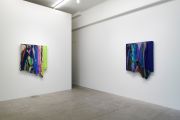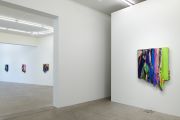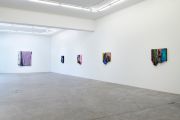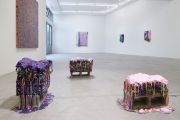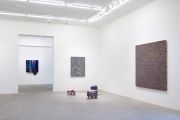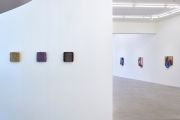Ju Ting
When the Wind Comes
September 9 – October 29, 2021
Galerie Urs Meile Lucerne
PRESS RELEASE – ENGLISH
Galerie Urs Meile is pleased to announce the second exhibition When the Wind Comes in Lucerne, by the Chinese artist Ju Ting (*1983), who lives and works in Beijing, China. Following her debut in our gallery in Switzerland in 2018 and her last show Scales in our Beijing gallery in 2019, this solo exhibition presents the artist’s progressive development in the three on-going series of her works - Pearl, Untitled and Coral.
The first impression of Ju Ting’s artworks is akin to the sensation of the first few steps upon arriving at a rocky desert. One is welcomed by an endless monotonous plain, empty, out of time. Ju’s technique of layering acrylic paint draws a landscape that neither invites nor repulses but just is. As a Chinese philosophical idea says, it is only when the heart moves that one may see movement: what we see reflects our own inner state. The same thought can be applied to Ju’s oeuvre: it gives you back what you give to it. Your gaze may follow the lazy dust in the wind, dancing with dry leaves and sticks. In the distance appears a fragile shimmer, warm air ascending in the sun. Almost like a wave in the sea, the slow hills roll across this panorama. A sudden edge reveals a spectrum of colors: layers of stone and rocks, layered on top of each other by millennia of wind, rain and movement. Cracks lead into the glittery light of gemstones in dark caverns. And between the hills runs canyon deep, a flowing river at its base, lush with crawling vegetation and the play of animals.
This is, arguably, the most painterly character of Ju’s work: its self-awareness as a blank canvas for imagination. The three series in the exhibition When the Wind Comes ground on layering acrylic and using its drying process to invite serendipity in. The pearl series consists of wooden bases that are covered in layers of alternatingly colored acrylic and parallel incisions running horizontally and vertically in close manner. The series untitled begins with similar layering only to be ripped down, hanging down like curtains after a storm. And coral consists of sculptures that are made of intertwined strips of acrylic placed on a grey brick, covered by layers of paint on top.
Ju’s application of acrylic follows layer by layer the natural behavior of the paint. With each layer this geology is accentuated more and more until the artwork resembles the profile of a landscape, with hills and waves running across the surface, some are even accentuated by the careful application of triangular strips of paint between the layers. It is by the long, parallel incisions that the vertical composition of color beneath the monochromous surface is revealed. Opposing colors delicately shine through, effecting a vibrant spectacle to contrast the tranquil geology on top.
In Pearl 061521 (2021, acrylic on board, 151 x 124 x 8 cm) the dark turquoise waves recall the unclear waters between a calm day and stormy winds. Turbulent life makes itself be seen to you through luminous colors between the waves as a salty-green scent ascends from the foamy coast. Ju offers you a panorama full of imaginative and affective potential. Without representational authority Ju evokes images from the personal memory and state of the heart. This makes this series so much more complex to describe beyond a mere technical description, as the experience is so individual and subject to change through time. Even more remarkable is the differing effect the works have from each other. Pearl 121819 (2019, acrylic on board, 183 x 153 x 9 cm), another large work within the series, has a widely differing impression due to its varying color composition. A silvery white surface covers another spectrum of colors that evoke other images, memories, and feelings than Pearl 061521 (2021, acrylic on board, 151 x 124 x 8 cm): snowy peaks that sit atop rocky darkness are equally present as a playful rainbow within the works topography. This is a painterly highlight in Ju’s practice, the composition of color as defining structure of the artwork that is reminiscent of western modernism and abstraction as Clement Greenberg championed. Though Ju takes a dramatically different route and benefits from the characteristics of acrylic that differ from classical oil paint.
Traditionally, color-based composition relied on the application of paint on a flat surface, the screen of the painting. This was due to the slow drying of oil paint and that once applied paint still can be mixed with new paint even days later. No matter how thick it was applied, the composition of color remained only possible by spatial separation on the canvas. The quality of the paint, its viscosity and luminosity, were thus highlighted by painting technique and composition. In contrast, acrylic paints quickly, allowing Ju to paint distinct layers of color on top of each other and expanding the possibility of composition into a vertical dimension: a feature she pushes beyond the limits of painting.
This characteristic is driven even further in the Untitled series that sees full layers of acrylic being torn away and left hanging like wet curtains. As one layer is pulled as far to the side as possible without completely ripping out, it creates an effect of layered curtains of individual colors and folding pattern. Again, the layering process unfolds as what may be called the composition of the work. In a spectacle of colors and surface structures Ju’s layering is revealed to you as the artistic principle of her work. The draped curtains result as multiple colors merge and display both differing colors on each side and surface structure: bubbly, silky, coarse, smooth. They equally narrate their own making by blatantly displaying the layering, tearing, and draping with which they evoke an imaginative space of mood. It is not exaggerated to notice that the whole series appears as covering a play that takes places in an infinite space behind infinite curtains. One gush of wind would suffice to blow them away, yet it has not come.
Contrasting that closeness in Untitled, Coral is probably the most open of the three exhibited series. In fact, it is so open that it may feel uncomfortable to look at and into its dark and shadowy corners. These sculptures are formed from stacked and intertwined strips of acrylic on top of a grey industrial brick. Covered by thick layers of acrylic on top, these strips revel in their meandering and remain ungraspable, alive. While Pearl and Untitled leave their inner working to be discovered by a curious gaze, Coral confronts you with its materiality and psychology: there is not much to discover in how it is made and nevertheless something seems to remain hidden behind the apparently living acrylic. Despite the heavy use of paint this series could not be further from painting: There is no surface or image to look at but rather a physical body. With Coral Ju pushes her use of painterly and printing techniques into the medium of sculpture. Despite this characteristic the objects remain far from the representational pitfalls of the medium and exhibit both a surprising self-awareness as well as their own material making. You can follow the artist’s labor of layering the strips on the brick and paying attention to remain within the rectangular shape of the base while towering up. To top it off, Ju poured various layers of color on top, letting it set on the organic surface and drip from the sides.
Ju’s deep material and technical knowledge from her education in printmaking enables her to develop an artistic oeuvre beyond the discreet categories of modern history of art. The merging of painterly material, the acrylic paint, and its treatment with techniques from the printmaking process, as carving and layering are, results in works that both unite characteristics from painting, printmaking, and sculpting and questions art history’s fixation with the media of art: Ju uses an artistic strategy that may be seen within the western modernist paradigm and nevertheless results in an aesthetic experience beyond art of the 20th century western canon. In a sense, the artist proposes nothing short of a new Laocoon, to reference once more Clement Greenberg, where the individual aesthetic experience lies at its core as the projection of an individual’s inner world. Ju’s works give as much back as they are given in the first place as they patiently wait for a new wind to reveal themselves.
Text by Mateo Chacón-Pino
Ju Ting (b. 1983, Shandong, China; lives and works in Beijing, China) is one of China’s foremost young female contemporary artists with a work characterized by coalescing two conventional art media: painting and sculpture, and obscuring the boundary between the two. Ju Ting graduated from the Printmaking Department with a BA in 2007, and with a master in 2013. Her works have been exhibited at Museum and institutions including OCT Contemporary Art Terminal, Xi’an, China; Stable Gallery of Lal Lal Estate, Melbourne, Australia; Shijiazhuang Art Museum, Shijiazhuang, China; Xinjiang Art Museum, Xinjiang, China, Taikang Space, Beijing, China; Today Art Museum, Beijing, China; Hi Art Center, Beijing, China. Her works are also in the collections of museum and institutions including National Art Museum of China, Beijing, China; Central Academy of Fine Arts, Beijing, China and White Rabbit Gallery, Sydney, Australia, etc.
PRESS RELEASE - DEUTSCH
Galerie Urs Meile freut sich, die zweite Ausstellung When the Wind Comes, der chinesischen Künstlerin Ju Ting (*1983), die in Peking lebt und arbeitet, in Luzern anzukündigen. Nach ihrem Debüt in unserer Galerie in der Schweiz im Jahr 2018 und ihrer letzten Ausstellung Scales in Peking im Jahr 2019, zeigt diese Einzelausstellung die fortschreitende Entwicklung der Künstlerin in den drei laufenden Serien ihrer Werke - Pearl, Untitled und Coral.
Auf den ersten Eindruck wirken Ju Tings Kunstwerke ähnlich diesem Gefühl, das einem während der ersten Schritte hinein in eine steinige Wüste befällt. Eine zeitlose, unendliche, leere Ebene empfängt einem. Ju erschafft mittels des Schichtens von Acrylfarbe Landschaften, die weder einladen noch zurückstossen, die einfach sind. Eine Idee aus der chinesischen Philosophie sagt, dass nur wenn das Herz sich bewegt, Bewegung gesehen werden kann: unser innerer Zustand wird von dem, was wir sehen, gespiegelt. Und derselbe Gedanke kann auf Jus Arbeit angewendet werden: Sie gibt zurück was ihr gegeben wird. Und so folgt der Blick dem trägen Staub im Wind in dieser Landschaft, wie er mit braunen Blättern tanzt, dem Schimmern warmer Luft an der Sonne und die Hügel rollen gemächlich über den Horizont, fast schon wie Wellen im Meer. Ein Riss entfaltet tausende Farben, Schichten aus Gestein, aufgetragen von Wind, Regen und stetem Wandel während tausenden Jahren. In deren Tiefe glitzern Edelsteine in dunklen Grotten. Und zwischen den Hügeln gräbt sich ein Fluss in eine Schlucht voller kriechender Sträucher und tollender Tiere.
Dieses Selbstbewusstsein als Projektionsfläche für die Vorstellungskraft der Betrachter ist womöglich die malerischste Qualität in Jus Arbeit. Die drei Werkgruppen in der Ausstellung When the Wind Comes basieren auf der Schichtung von Acrylfarbe und der Nutzung von deren Trocknungsprozess um überraschende Effekte zu erzeugen. In der Serie Pearl schichtet die Künstlerin unterschiedliche Farben aufeinander auf einer Holzbasis, in welche sie nach dem Trocknen eng aneinander liegende horizontale und vertikale Furchen schneidet. Die Reihe Untitled beginnt mit einem ähnlichen Prozess, jedoch werden die Schichten schliesslich heruntergerissen und wie vom Sturm durchnässte Stoffe hängengelassen. Und schliesslich bestehen die Skulpturen der Reihe Coral aus Acrylstreifen, die Ju miteinander verwebt und auf grauen Backsteinen auflegt, bevor sie diese noch mit Farben übergiesst.
Vorsichtig trägt Ju Schicht um Schicht aus Acryl auf den Träger von Pearl. Jede neue Schicht betont die entstehende Geologie des Kunstwerkes bis es dem Profil einer Landschaft gleicht, mit all den Hügeln und Wellen, die über dessen Oberfläche schlagen. Manche Wellen betont die Künstlerin durch Acrylstreifen, die sie zwischen den Schichten legt. Und schliesslich eröffnet sich dem Betrachter die vertikale Komposition durch die Einschnitte in der monochromen Oberfläche. Kontrastierende Farben erscheinen und erzeugen ein Spektakel unter der ruhigen Geologie der obersten Schicht.
Die dunklen, türkisen Wellen in Pearl 061521 (2021, Acryl auf Holztafel, 151 x 124 x 8 cm) erscheinen wie unruhige Wasser am Wechsel zwischen einem ruhigen Tag und stürmischen Wolken. In den finsteren Gewässern lässt sich leuchtendes Fischleben erblicken und ein salzig-grüner Geruch steigt aus der schaumigen Küste. Jus Landschaften entfalten vor dem Betrachter ein imaginatives und emotionales Potential. Sie ruft mit ihrer Arbeit, frei von figurativer Autorität, Bilder aus der persönlichen Erinnerung auf und reflektiert damit den eigenen emotionalen Zustand. Und diese individuelle Erfahrung, die sich auch mit der Zeit ändert, macht es so schwierig, diese Werkgruppe jenseits einer technischen Beschreibung nachzuvollziehen. Eindrücklich sind auch die unterschiedlichen Effekte, die die einzelnen Kunstwerke auslösen können. So hinterlässt die farbliche Komposition der grossen Arbeit Pearl 121819 (2019, Acryl auf Holztafel, 183 x 153 x 9 cm) einen komplett anderen Eindruck als Pearl 061521 (2021, Acryl auf Holztafel, 151 x 124 x 8 cm): eine silbrig-weisse Oberfläche bedeckt ein Farbspektrum, welches Bilder und Erinnerungen an schneeverwehte Gipfel in der Dunkelheit und regenbogenfarbene Topografien aufgreift. Die farbliche Komposition als Hauptcharakteristik der Arbeit entspricht auch der modernen, westlichen Tradition derMalerei, ganz wie sie Clement Greenberg zelebrierte, mit dem Unterschied, dass Ju sich statt mit klassischer Ölfarbe mit den materiellen Eigenschaften des Acryls auseinandersetzt.
Die traditionelle Farbkomposition basiert aufgrund des langsamen Trocknen von Ölfarbe auf der Aufteilung der Leinwand in Farbflächen: denn nachträglich aufgetragene Farbe vermischt sich auch Tage später mit der darunterliegenden. Die räumliche Trennung wird notwendig, um die Kontrolle über die Farben zu behalten. Gleichzeitig heben sich so auch die Charakteristiken der Ölfarbe, ihre Leuchtkraft und ihre Viskosität, im Duktus und in der Komposition hervor. Acryl trocknet im Gegensatz dazu schnell, was Ju nutzt, um getrennte Farbschichten aufzutragen und somit die Farbkomposition in die Vertikale zu verschieben und über die Grenzen der Malerei hinaus auszureizen.
In der Reihe Untitled erforscht Ju diese Möglichkeiten, indem sie ganze Acrylschichten von der Fläche reisst und diese wie nasse Vorhänge vor dem Bild hängen lässt. Da jede Schicht nur so weit zurückgezogen wird, wie die vorherige es zulässt, wirken sie wie unendliche Vorhänge aus unterschiedlichen Farben, Texturen und Falten. Diese Technik bedient sich an der vertikalen Komposition der Farbe, Jus künstlerisches Prinzip, um sich als leuchtendes Spektakel in tausenden Falten zu präsentieren. Die drapierten Vorhänge zeigen unterschiedliche Farben und Strukturen auf jeder Seite, glatt, schaumig, seiden, rau. Das Herunterreissen der Acrylfarbe, das Schichten und Drapieren zeigen zugleich die Beschaffenheit der Arbeit, als auch einen Raum für emotionale Vorstellungskraft: diese ganze Werkgruppe erscheint wie die Verhüllung eines Theaterstücks in einem unendlichen Raum hinter unendlichen Vorhängen. Um sie beiseite zuwehen reicht ein Windstoss, der noch kommen wird.
Im Kontrast zur Verschlossenheit in Untitled steht Coral, die wohl offenste Werkreihe in der Ausstellung. Tatsächlich sind sie so offen, dass das Starren in ihre dunkle und schattige Leere Beklemmung hervorruft. Diese Skulpturen entstehen durch das Auftürmen verschlungener Acrylstreifen auf einem grauen Backstein. Diese herumschlängelnden, ungreifbaren, lebendigen Streifen werden mit Acrylfarben übergossen. Pearl und Untitled überlassen ihr inneres Leben einem neugierigen Auge, während Coral die Betrachter mit ihrer Materialität und Psychologie konfrontiert, sie überlässt über ihre Beschaffenheit weniger der Vorstellungskraft und dennoch scheint sich etwas hinter der Acrylfarbe zu verbergen. Trotz des intensiven Gebrauchs des Acryls bleibt diese Serie fern vom Medium der Malerei: es gibt keine Oberfläche oder Bild, das betrachtet werden kann, ausser einem Körper aus Acryl. Ju treibt in Coral die Mal- und Drucktechnik eindeutig ins Medium der Skulptur, jedoch ohne in die Falle gegenständlicher Darstellung zu treten. Vielmehr zeugen die Arbeiten von einem überraschenden Selbstbewusstsein, auch über ihre eigene Beschaffenheit. Es fällt leicht, dem Arbeitsprozess der Künstlerin, das achtsame Verflechten der Acrylstreifen auf dem Backstein, das Übergiessen mit Farbe bis eine organische Oberfläche und Tropfreste auf allen Seiten entstehen, zu folgen.
Jus grosse Erfahrung mit Material und Technik der Druckkunst verhilft ihr dazu, ein künstlerisches Œuvre zu entwickeln, welches die Kategorien der modernen Kunstgeschichte sprengt. Die Verbindung von Malfarbe und Techniken aus dem Druck, das Einschneiden und Schichten, ergibt Kunstwerke, die sich der Fixierung der Kunstgeschichte auf das Medium entziehen: Ju nutzt künstlerische Strategien aus der Malerei, dem Druck und der Bildhauerei, die zweifelsohne in das Paradigma der westlichen Moderne passen und trotzdem eine ästhetische Erfahrung jenseits des Kunstkanons des 20. Jahrhunderts erzeugen. In diesem Sinne schlägt die Künstlerin nichts anderes vor als einen neuen Laokoon, um nochmals Clement Greenberg zu zitieren, der die individuelle ästhetische Erfahrung und die Projektion dessen emotionaler Welt im Fokus hat. So geben Ju’s Arbeiten auch das wieder, was ihnen gegeben wird, während sie auf einen neuen Windstoss warten, um zu tanzen.
Text von Mateo Chacón-Pino
Ju Ting (geb. 1983, Shandong, China; lebt und arbeitet in Peking, China) ist eine der führenden jungen zeitgenössischen Künstlerinnen Chinas. Ihr Werk zeichnet sich dadurch aus, dass sie zwei konventionelle Kunstmedien - Malerei und Skulptur - miteinander verschmilzt und die Grenze zwischen beiden verwischt. Ju Ting schloss ihr Studium der Druckgrafik 2007 mit einem BA und 2013 mit einem Master ab. Ihre Werke wurden in Museen und Institutionen ausgestellt, darunter OCT Contemporary Art Terminal, Xi’an, China; Stable Gallery of Lal Lal Estate, Melbourne, Australien; Shijiazhuang Art Museum, Shijiazhuang, China; Xinjiang Art Museum, Xinjiang, China, Taikang Space, Beijing, China; Today Art Museum, Beijing, China; Hi Art Center, Beijing, China. Ihre Werke befinden sich auch in den Sammlungen von Museen und Institutionen wie dem National Art Museum of China, Peking, China, der Central Academy of Fine Arts, Peking, China und der White Rabbit Gallery, Sydney, Australien, usw.
OPENING
September 9, Thursday; 5:30-7:30 pm

